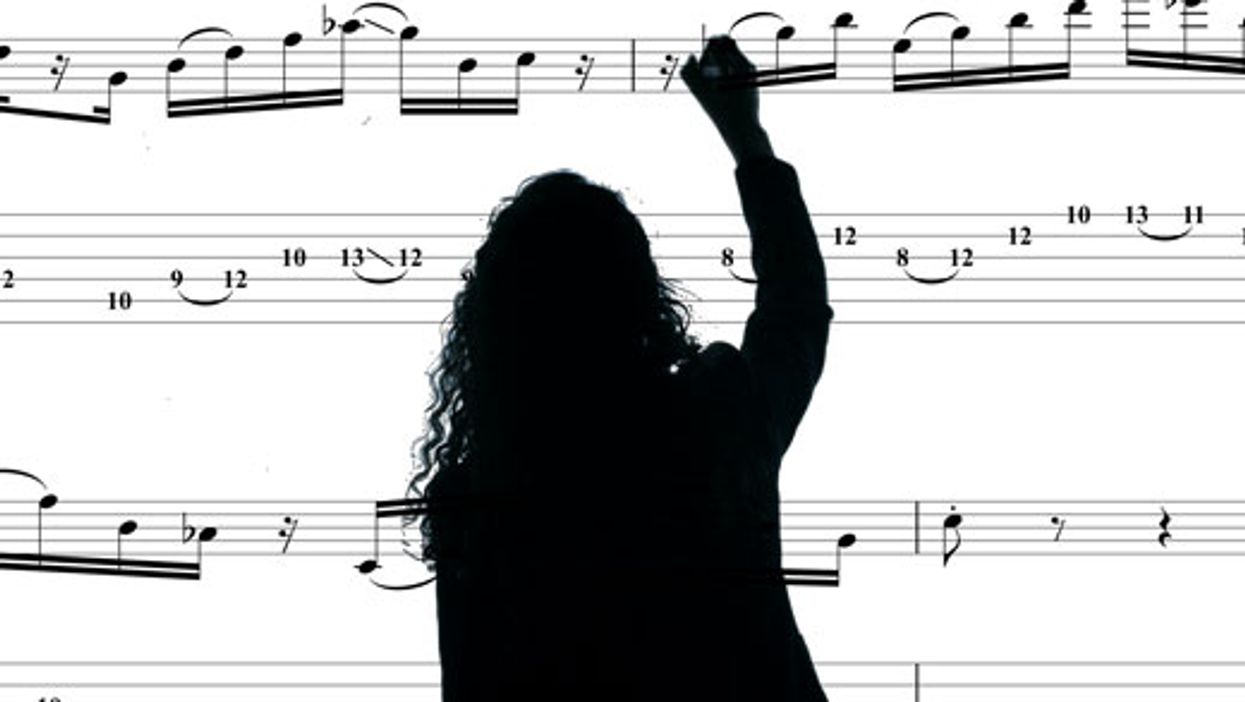Have you watched pole-vaulters on the
Olympics?
I’ve always wondered what a lesson for a beginning pole-vaulter might look like. How do you practice something like this slowly? I suppose you could travel to the moon where there is less gravity or maybe practice underwater where you could float rather than suffer a nasty drop to the earth every time you make a mistake. My guess is that budding pole-vaulters don’t do either of those impractical things. They probably just do a lot of falling and get bruised up more than the rest of us could endure. My respect goes out to the pole-vaulters of the world.
Back to the world of guitar.
I’ve planted a vision of bruised pole-vaulters in your head to mentally prepare you for something difficult and painful on the guitar. But I’m going to do the opposite and give you something easy to play. Breathe a sigh of relief and get ready to play ... two notes. Easy, right? And you can practice them slowly without any worries of falling to the ground. I want to make this into a rhythmic phrase, so I repeated these notes a few times. The right hand will use alternate picking, starting with a downstroke.
I really want you to remember this phrase, so instead of using the generic title “Fig. 1,” let’s rename it Color TVs. It’s an unusual name, but I’ll bet you won’t forget it.
Download Example Audio 1...

At this point, you may already be wondering where this is leading. So I’ll tell you. In this column, I’m going to show the best thing I have ever played. What do I mean by that? I mean this is it. This is the SECRET. This opens so many locked doors of technique and I’ve finally developed a good idea of how to explain it clearly.
Let’s go to the next step. Do you remember the easy phrase that you played a minute ago? Let’s play it again. While you’re playing it, take a look at it, and ask yourself one question: How many strings are you using? This is not a trick question. The answer is one string. Now, I want to play the same phrase using—brace yourself— two strings! I want you to remember this second phrase as well. So let’s get rid of the generic title “Fig. 2”, and call it Refrigerators instead.
Download Example Audio 2...

It’s still just two notes. But since they are on different strings, we now have some picking decisions to make. We’ve come to a crossroads. I’m going to suddenly transform into a cruel, dogmatic, knuckle-rapping taskmaster, and insist with a loud voice that you must use outside picking.
In this case, “outside” picking means that the first note—in this case, D—is always played with an upstroke and the second note is always played with a downstroke. Your pick will never go in between (inside) the two strings. Instead your pick will stay outside the strings, hence the term. Outside picking is better for these two notes. “Inside” picking is absolutely valuable, has its place, and is better in many other situations. But please keep it away from these two notes! Now let’s assemble a life-changing guitar exercise. We’ll put Color TVs and Refrigerators together.
Download Example Audio 3...

Let’s stop right here for a second. This exercise is so important that I want to give you some advice on how to master it. The loud-talking taskmaster returns and says:
What am I talking about? Let’s look at our Color TVs for a second. It’s basically two notes on one string. We’ve been picking every note. But we don’t have to! The taskmaster will still loudly demand that you pick the first note. But after that, the left hand can take over with pull-offs and hammer-ons. No more picking is required. You don’t have to move these Color TVs.
The Refrigerators still need to be moved. But because you could take a break from the Color TVs, you’ll be quicker and more powerful when you get to the Refrigerators. Here is a lick where this concept really pays off. Let’s call this one That’s the Way You Do It.
Download Example Audio 4...

This lick is downright revolutionary. There are no Color TVs, only Refrigerators. And the result is that you can play a phrase that uses three separate strings with similar speed and ease as if they were on a single string. This solves possibly the biggest technical challenge of playing scales and arpeggios on a guitar.
Now, before we invest three weeks in this phrase, let’s ask an important moral question: Isn’t it morally superior to pick every note? Aren’t we being lazy for making the left hand deal with the Color TVs while the right hand takes a break? Doesn’t picking sound better? Shouldn’t we practice picking every note to build better technique?
The answer is no. A hammer-on or pull-off has the same moral value as a picked note. Hammer-ons and pull-offs sound great and in this case, they make the difference between a lick being comfortable and playable, or being stiff and impossible. You shouldn’t move these Color TVs. It would mess up the lick.
Okay, the taskmaster is back. It’s time to practice. Keep in mind that this lick has six notes, a triplet feel, and should work well over a shuffle groove. As always, start slow and make sure the picking strokes are correct. Don’t pick more often than you need to. The biggest mistake students make with this is they start moving the Color TVs. You don’t have to. And the lick will fall apart if you do. Move the Refrigerators only. I want that lick firmly embedded in the part of your brain that acts out of instinct and habit. That takes three weeks. It’s well worth it to experience a revolution.
All right. You’re back again. There is no bad news. Only good. “That’s the Way You Do It” has so many applications and variations that I don’t know where to begin. Or maybe I do. All we did here was add a couple of notes with our left hand. Our Refrigerators remain the same. You’ve already put in the practice for this picking pattern, so there’s a good chance it will work immediately. That’s why I’m going to rename it, Money for Nothing.
Download Example Audio 5...

At a medium tempo this will sound like 16th-notes. But as it speeds up, I’ve found that the picking accents can make it sound like 16th-note triplets. I really like how this fools the ear. It’s actually using eight notes to sound like nine. It’s almost like someone smuggled in an extra Color TV. This will sound good over a shuffle groove, and could be written like this next example.
To give you a small taste of where you can go with these techniques, I’ll give you two more variations. Both keep our picking pattern the same, but use different fingerings and note choices. The first uses notes from the blues scale and a shape that’s easy for the left hand. I’m too deep into my metaphor now to call this one anything but, Chicks for Free.
Download Example Audio 6...

The next example, Maybe Get a Blister on Your Little Finger, has a bigger left-hand stretch and is a great way to play a blistering minor-7th arpeggio.
Download Example Audio 7...

I have taught some of these phrases before using clearly notated videos and tablature. But after watching students play them, I realized that the exact picking pattern is crucial to making these work. In almost every case, the problem was that the student was applying old picking habits and trying to pick too many notes. This left them tangled up and unsuccessful. The solution is to pick less. This requires less motion and very specific coordination. When going from string to string, you’ve got to pick it. When playing more than one note on the same string, you only have to pick the first note and not the others. You’ve got to move those Refrigerators. You don’t have to move those Color TVs.
 Paul Gilbert purposefully began playing guitar
at age 9, formed the guitar-driven bands
Racer X and Mr. Big, and then accidentally
had a No. 1 hit with an acoustic song called
“To Be with You.” Paul began teaching at
GIT at the age of 18, has released countless
albums and guitar instructional DVDs, and
will remembered as “the guy who got the drill
stuck in his hair.” For more information, visit
paulgilbert.com
Paul Gilbert purposefully began playing guitar
at age 9, formed the guitar-driven bands
Racer X and Mr. Big, and then accidentally
had a No. 1 hit with an acoustic song called
“To Be with You.” Paul began teaching at
GIT at the age of 18, has released countless
albums and guitar instructional DVDs, and
will remembered as “the guy who got the drill
stuck in his hair.” For more information, visit
paulgilbert.com
I’ve always wondered what a lesson for a beginning pole-vaulter might look like. How do you practice something like this slowly? I suppose you could travel to the moon where there is less gravity or maybe practice underwater where you could float rather than suffer a nasty drop to the earth every time you make a mistake. My guess is that budding pole-vaulters don’t do either of those impractical things. They probably just do a lot of falling and get bruised up more than the rest of us could endure. My respect goes out to the pole-vaulters of the world.
Back to the world of guitar.
I’ve planted a vision of bruised pole-vaulters in your head to mentally prepare you for something difficult and painful on the guitar. But I’m going to do the opposite and give you something easy to play. Breathe a sigh of relief and get ready to play ... two notes. Easy, right? And you can practice them slowly without any worries of falling to the ground. I want to make this into a rhythmic phrase, so I repeated these notes a few times. The right hand will use alternate picking, starting with a downstroke.
I really want you to remember this phrase, so instead of using the generic title “Fig. 1,” let’s rename it Color TVs. It’s an unusual name, but I’ll bet you won’t forget it.
Download Example Audio 1...
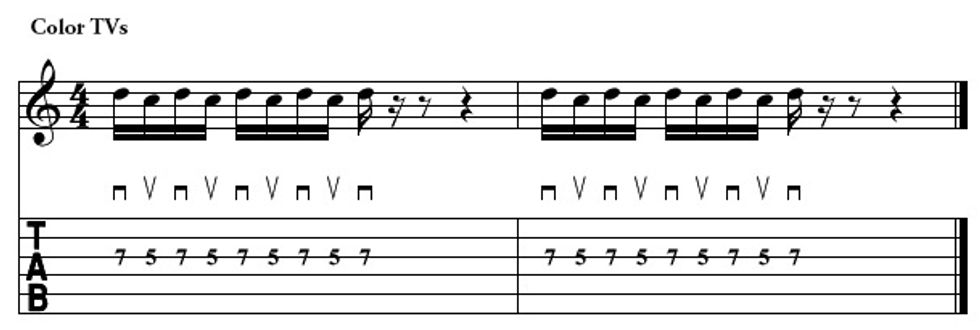
At this point, you may already be wondering where this is leading. So I’ll tell you. In this column, I’m going to show the best thing I have ever played. What do I mean by that? I mean this is it. This is the SECRET. This opens so many locked doors of technique and I’ve finally developed a good idea of how to explain it clearly.
Let’s go to the next step. Do you remember the easy phrase that you played a minute ago? Let’s play it again. While you’re playing it, take a look at it, and ask yourself one question: How many strings are you using? This is not a trick question. The answer is one string. Now, I want to play the same phrase using—brace yourself— two strings! I want you to remember this second phrase as well. So let’s get rid of the generic title “Fig. 2”, and call it Refrigerators instead.
Download Example Audio 2...
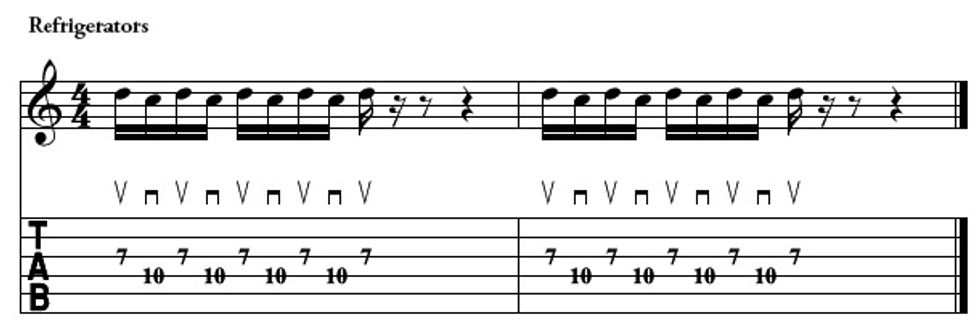
It’s still just two notes. But since they are on different strings, we now have some picking decisions to make. We’ve come to a crossroads. I’m going to suddenly transform into a cruel, dogmatic, knuckle-rapping taskmaster, and insist with a loud voice that you must use outside picking.
In this case, “outside” picking means that the first note—in this case, D—is always played with an upstroke and the second note is always played with a downstroke. Your pick will never go in between (inside) the two strings. Instead your pick will stay outside the strings, hence the term. Outside picking is better for these two notes. “Inside” picking is absolutely valuable, has its place, and is better in many other situations. But please keep it away from these two notes! Now let’s assemble a life-changing guitar exercise. We’ll put Color TVs and Refrigerators together.
Download Example Audio 3...

Let’s stop right here for a second. This exercise is so important that I want to give you some advice on how to master it. The loud-talking taskmaster returns and says:
• Notice that the Color TVs begin with a downstroke, while the Refrigerators begin with an upstroke. The space in between will allow you time to get ready for the change in picking.Hello! You’re back. Three weeks have passed, and you have digested the examples all the way back into the reptilian part of your brain. No barrier or distraction can stop you from playing it as easy as an E chord. You can play it on a guitar, with strings that are too high while plugged into an amp with a sound that you don’t like with a monitor where you can’t hear yourself, with a drummer with erratic meter, a bass player who is out of tune, an audience that is asking for more Bee Gees tunes, and a dog that keeps eating your homework. You don’t need to make excuses. You can play it easily every time. That’s what three weeks does. So now, you are ready for the secret. You still have to move these Refrigerators. But you do not have to move these Color TVs.
• Keep the tempo slow. The important things are: Use the correct picking strokes and keep the rhythm even and flowing.
• Respect the holes. Keep them in tempo just like you would if they were notes.
• Notice that every note is picked. My metaphor pays off here. “You’ve got to move these refrigerators. You’ve got to move these color TVs.”
• Practice. It takes 21 days for your brain to take a new physical motion and turn it into a motor skill. How long each day? I’d guess about 15 minutes a day, spread out in five-minute sessions. It’s such a simple lick, that any more than that might get boring and that’s the last thing we want.
What am I talking about? Let’s look at our Color TVs for a second. It’s basically two notes on one string. We’ve been picking every note. But we don’t have to! The taskmaster will still loudly demand that you pick the first note. But after that, the left hand can take over with pull-offs and hammer-ons. No more picking is required. You don’t have to move these Color TVs.
The Refrigerators still need to be moved. But because you could take a break from the Color TVs, you’ll be quicker and more powerful when you get to the Refrigerators. Here is a lick where this concept really pays off. Let’s call this one That’s the Way You Do It.
Download Example Audio 4...
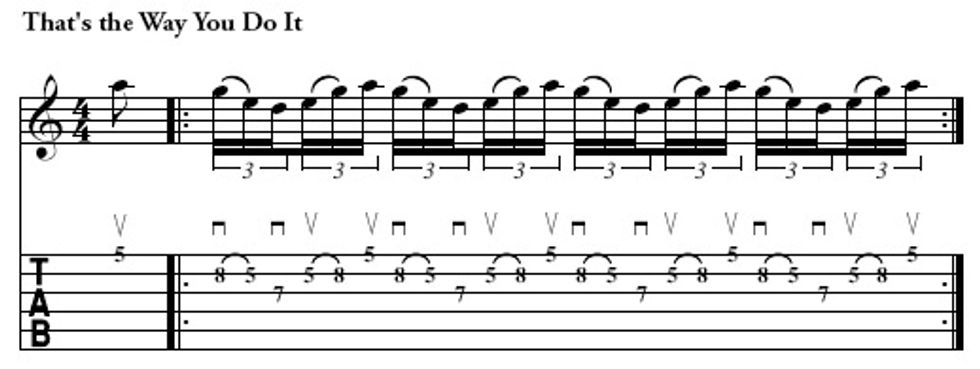
This lick is downright revolutionary. There are no Color TVs, only Refrigerators. And the result is that you can play a phrase that uses three separate strings with similar speed and ease as if they were on a single string. This solves possibly the biggest technical challenge of playing scales and arpeggios on a guitar.
Now, before we invest three weeks in this phrase, let’s ask an important moral question: Isn’t it morally superior to pick every note? Aren’t we being lazy for making the left hand deal with the Color TVs while the right hand takes a break? Doesn’t picking sound better? Shouldn’t we practice picking every note to build better technique?
The answer is no. A hammer-on or pull-off has the same moral value as a picked note. Hammer-ons and pull-offs sound great and in this case, they make the difference between a lick being comfortable and playable, or being stiff and impossible. You shouldn’t move these Color TVs. It would mess up the lick.
Okay, the taskmaster is back. It’s time to practice. Keep in mind that this lick has six notes, a triplet feel, and should work well over a shuffle groove. As always, start slow and make sure the picking strokes are correct. Don’t pick more often than you need to. The biggest mistake students make with this is they start moving the Color TVs. You don’t have to. And the lick will fall apart if you do. Move the Refrigerators only. I want that lick firmly embedded in the part of your brain that acts out of instinct and habit. That takes three weeks. It’s well worth it to experience a revolution.
All right. You’re back again. There is no bad news. Only good. “That’s the Way You Do It” has so many applications and variations that I don’t know where to begin. Or maybe I do. All we did here was add a couple of notes with our left hand. Our Refrigerators remain the same. You’ve already put in the practice for this picking pattern, so there’s a good chance it will work immediately. That’s why I’m going to rename it, Money for Nothing.
Download Example Audio 5...

At a medium tempo this will sound like 16th-notes. But as it speeds up, I’ve found that the picking accents can make it sound like 16th-note triplets. I really like how this fools the ear. It’s actually using eight notes to sound like nine. It’s almost like someone smuggled in an extra Color TV. This will sound good over a shuffle groove, and could be written like this next example.
To give you a small taste of where you can go with these techniques, I’ll give you two more variations. Both keep our picking pattern the same, but use different fingerings and note choices. The first uses notes from the blues scale and a shape that’s easy for the left hand. I’m too deep into my metaphor now to call this one anything but, Chicks for Free.
Download Example Audio 6...
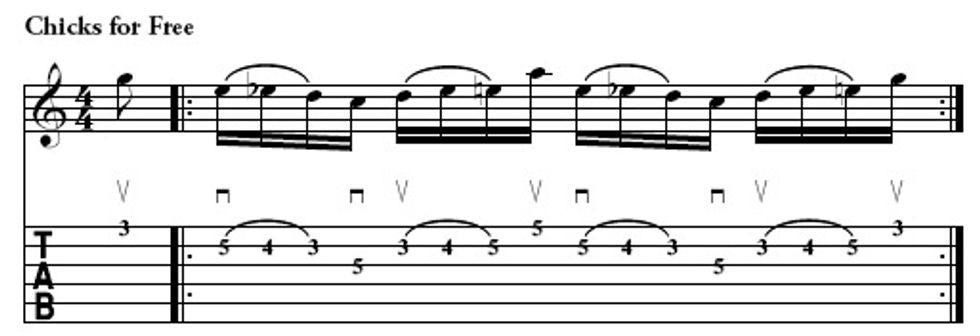
The next example, Maybe Get a Blister on Your Little Finger, has a bigger left-hand stretch and is a great way to play a blistering minor-7th arpeggio.
Download Example Audio 7...
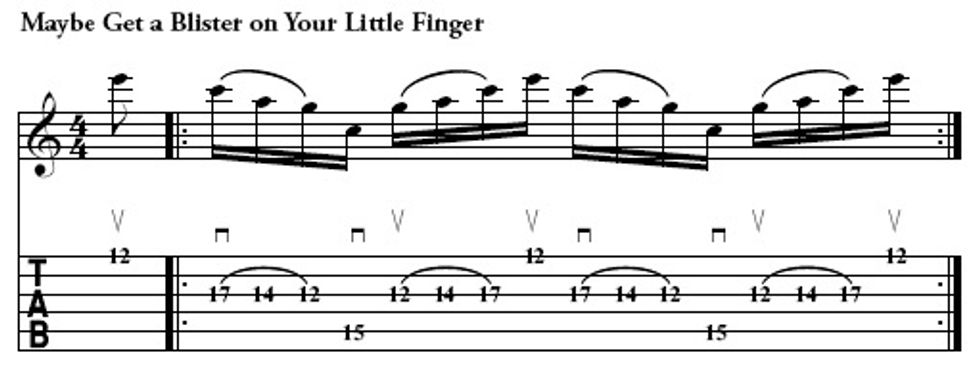
I have taught some of these phrases before using clearly notated videos and tablature. But after watching students play them, I realized that the exact picking pattern is crucial to making these work. In almost every case, the problem was that the student was applying old picking habits and trying to pick too many notes. This left them tangled up and unsuccessful. The solution is to pick less. This requires less motion and very specific coordination. When going from string to string, you’ve got to pick it. When playing more than one note on the same string, you only have to pick the first note and not the others. You’ve got to move those Refrigerators. You don’t have to move those Color TVs.
 Paul Gilbert purposefully began playing guitar
at age 9, formed the guitar-driven bands
Racer X and Mr. Big, and then accidentally
had a No. 1 hit with an acoustic song called
“To Be with You.” Paul began teaching at
GIT at the age of 18, has released countless
albums and guitar instructional DVDs, and
will remembered as “the guy who got the drill
stuck in his hair.” For more information, visit
paulgilbert.com
Paul Gilbert purposefully began playing guitar
at age 9, formed the guitar-driven bands
Racer X and Mr. Big, and then accidentally
had a No. 1 hit with an acoustic song called
“To Be with You.” Paul began teaching at
GIT at the age of 18, has released countless
albums and guitar instructional DVDs, and
will remembered as “the guy who got the drill
stuck in his hair.” For more information, visit
paulgilbert.com



